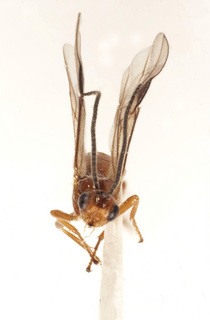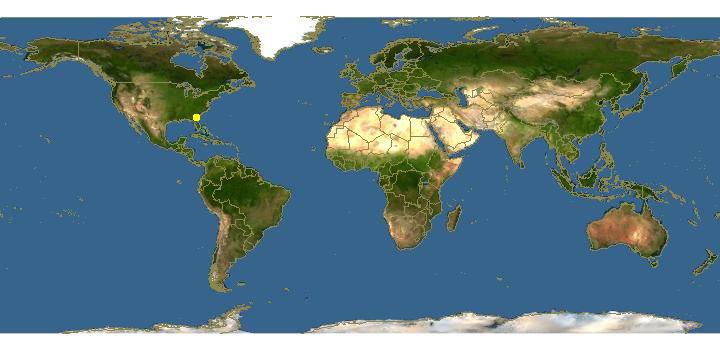
Jaime Fuest, University of Georgia · 0
Bracon sanninoideae |

Click on map for details about points.
|
|
Identification |
The original species description is presented here in text form.
Gahan, A.B. 1917. Descriptions of some new parasitic Hymenoptera. Proc. U.S. Nat. Mus. 53:195-197.
MICROBRACON SANNINOIDEAE, new species.
Very similar to mellitor Say but differs as follows: The eyes are
larger, more bulging and slightly wider in proportion to their length;
the nervulus is usually exactly interstitial; the third abscissa of
radius is longer than the combined first and second abscissae; the
second abscissa of cubitus is usually distinctly shorter than the
recurrent nervure; the second abdominal tergite is not emarginate
medially, the suturiform articulation being straight instead of
angularly broken at the middle.
Female.-Length 2.25 to 4 mm. Face finely shagreened; head above and
the thorax smooth and polished; propodeum mostly smooth but with the
apical half more or less rugulose; abdominal tergites finely wrinkled
or shagreened; ovipositer exserted the length of the abdomen or a
little more. Eyes and ovipositor sheaths black; flagellum dark borwn
or blackish; tips of mandibles and the tarsi brownish; wings slightly
dusky, the costal vein and stigma dark brown, other veins paler;
remainder of the body reddish testaceous, the mesonotum sometimes
stained with blackish.
Male.-Similar to the female, but more often with the mesonotum and
occasionally the mesosternum stained with blackish.
Type-locality.-College Park, Maryland.
Type.-Cat. No. 20374, U.S.N.M.
Host.-Sanninoidea exitiosa.
Described from many specimens reared by the writer from the cocoons of
the peach-tree borer and recorded under Maryland Experiment Station
Accession Cat. No. 809.
This species has been confused with mellitor in the literature, but
can not be that species, since mellitor is a solitary parasite of
Anthonomus grandis while sanninoideae is always gregarious, as many as 35 specimens often emerging from a single host cocoon.
|
|
|
Names | |
Microbracon sanninoideae
|
|
|
Geographic distribution | |
This species occurs at least from Connecticut to Georgia, westward to Kansas and Arkansas (Muesebeck, 1925).
|
|
|
Natural history |
The members of the genus Bracon are known to utilize a diverse array of concealed larave of the orders Coleoptera and Lepidoptera (Quicke and Sharkey, 1989).
Bracon sanninoideae is also a parasitoid of Synanthedon scitula, the pecan tree borer (Underhill, 1935), S. rhododendri, S. tipuliformis, and Podosesia syringae (Solomon, 1995). This is a gregarious species of parasitoid, producing approximately 35 wasps per peach tree borer pupa (Gahan, 1917).
|
|
|
References | |
Gahan, A.B. 1917. Descriptions of some new parasitic Hymenoptera. Proc. U.S. Nat. Mus. 53:195-197.
Muesebeck, C.F.W. 1925. A revision of the parasitic wasps of the genus Microbracon occurring in America north of Mexico. Proc. U. S. Nat. Mus. 67:1-85.
Quicke, D.L.J. and M.J. Sharkey. 1989. A key to and notes on the genera of Braconinae (Hymenoptera: Braconidae) from America norht of Mexico with descriptions of two new genera and three new species. Canadian Entomologist 121:337-361.
Solomon, J.D. 1995. Guide to Insect Borers of North American broadleaf trees and shrubs. Agric. Handbook. 706. Washington, D.C.: U.S. Department of Agriculture, Forest Service. 735p.
Underhill, G.W. 1935. The pecan tree borer in dogwood. Journal of Economic Entomology 28: 393-396.
|
|
|
Acknowledgements | |
The specimen photographed was captured in a malaise trap in Charlotte (Mecklenburg Co.), North Carolina on 13-VI-1977. Receipt of this specimen loan arranged by Dr. B. Blinn and the North Carolina State University Insect Collection is gratefully acknowledged by the author.
|
|
| Supported by | |
Updated: 2024-04-25 00:44:12 gmt
|